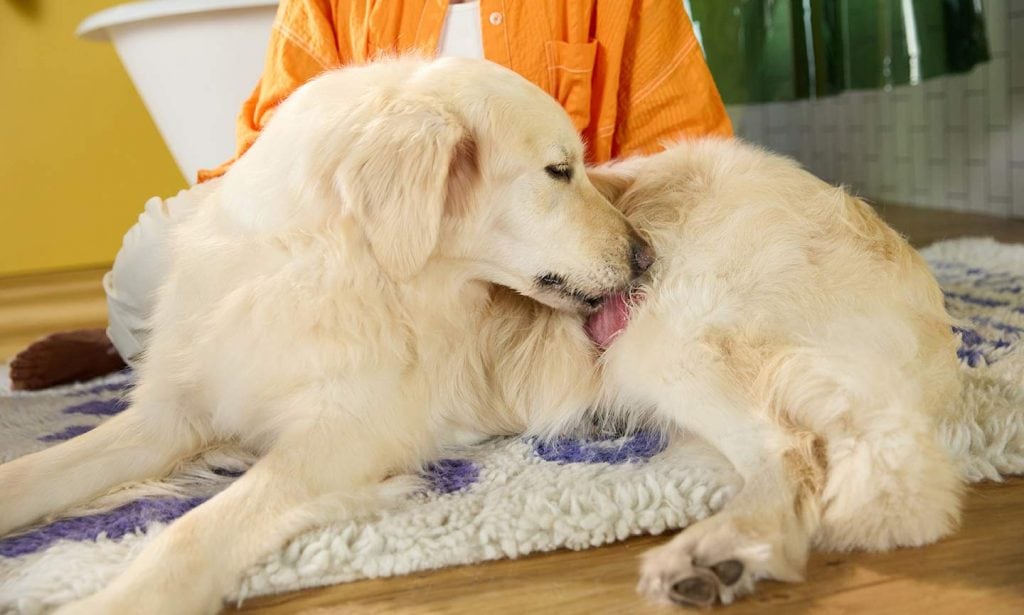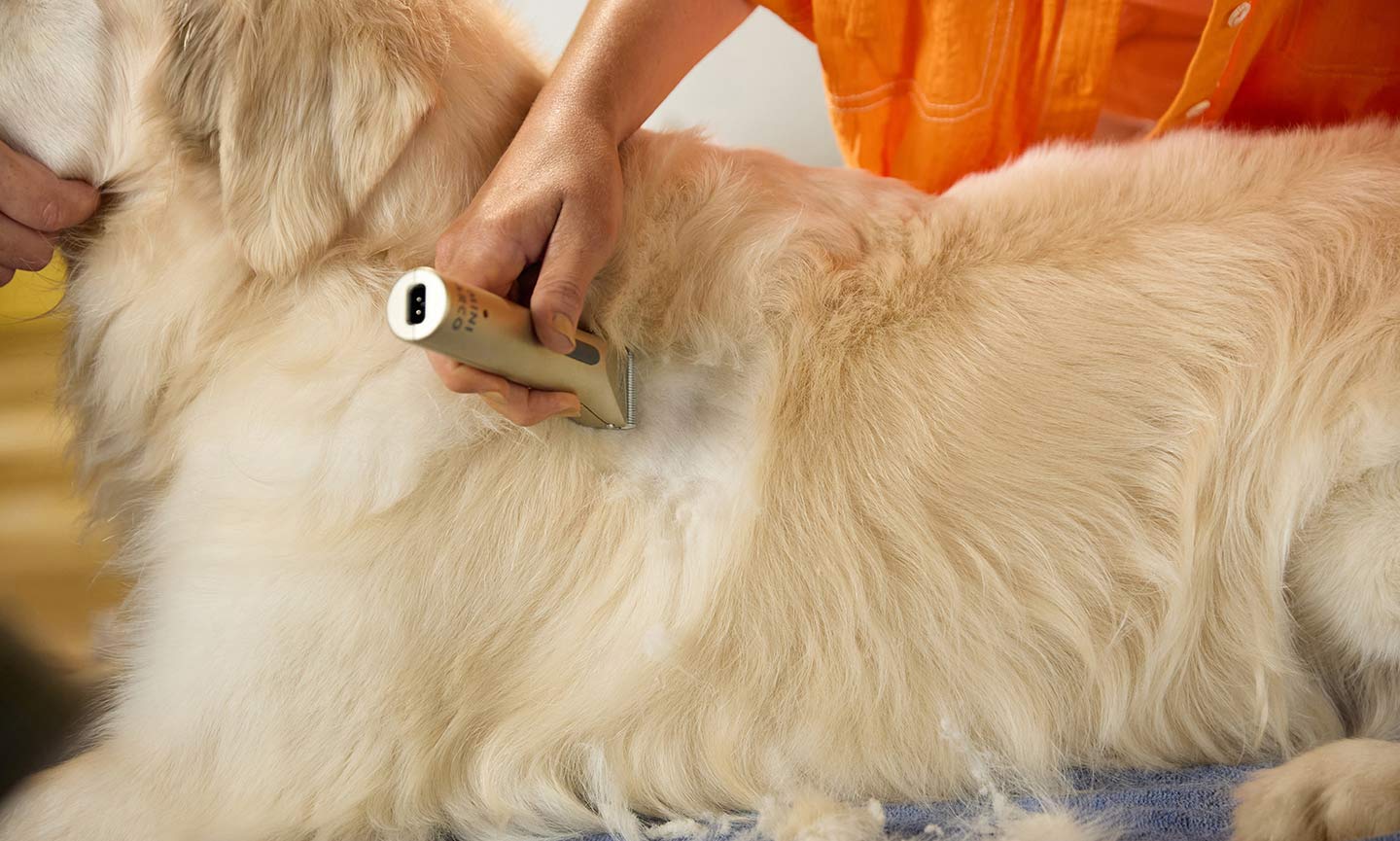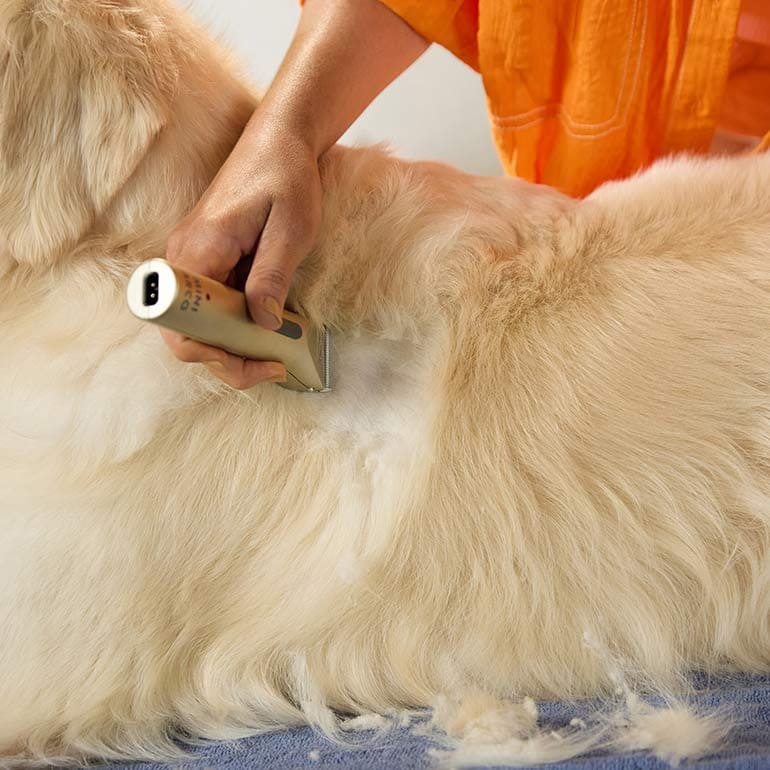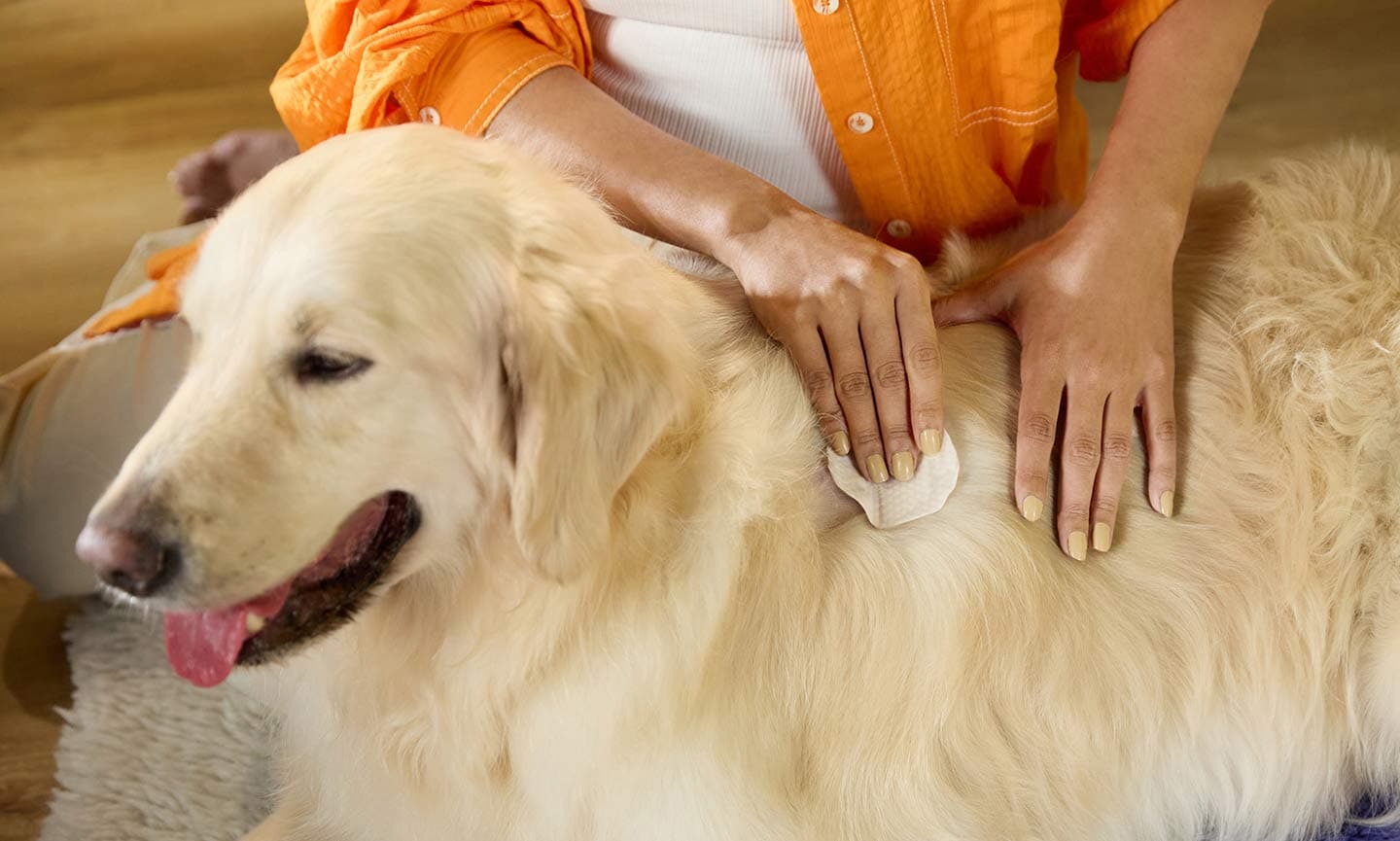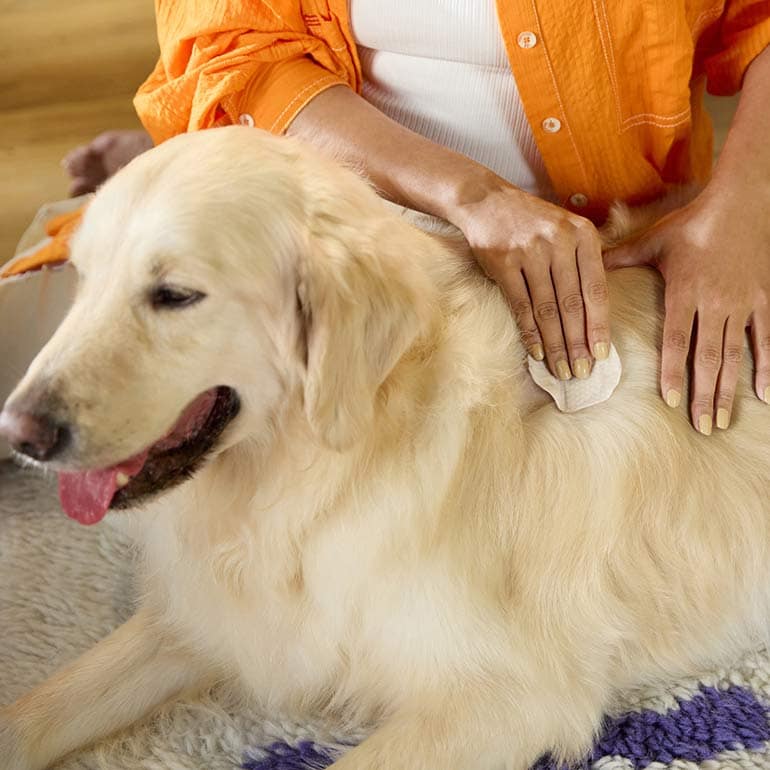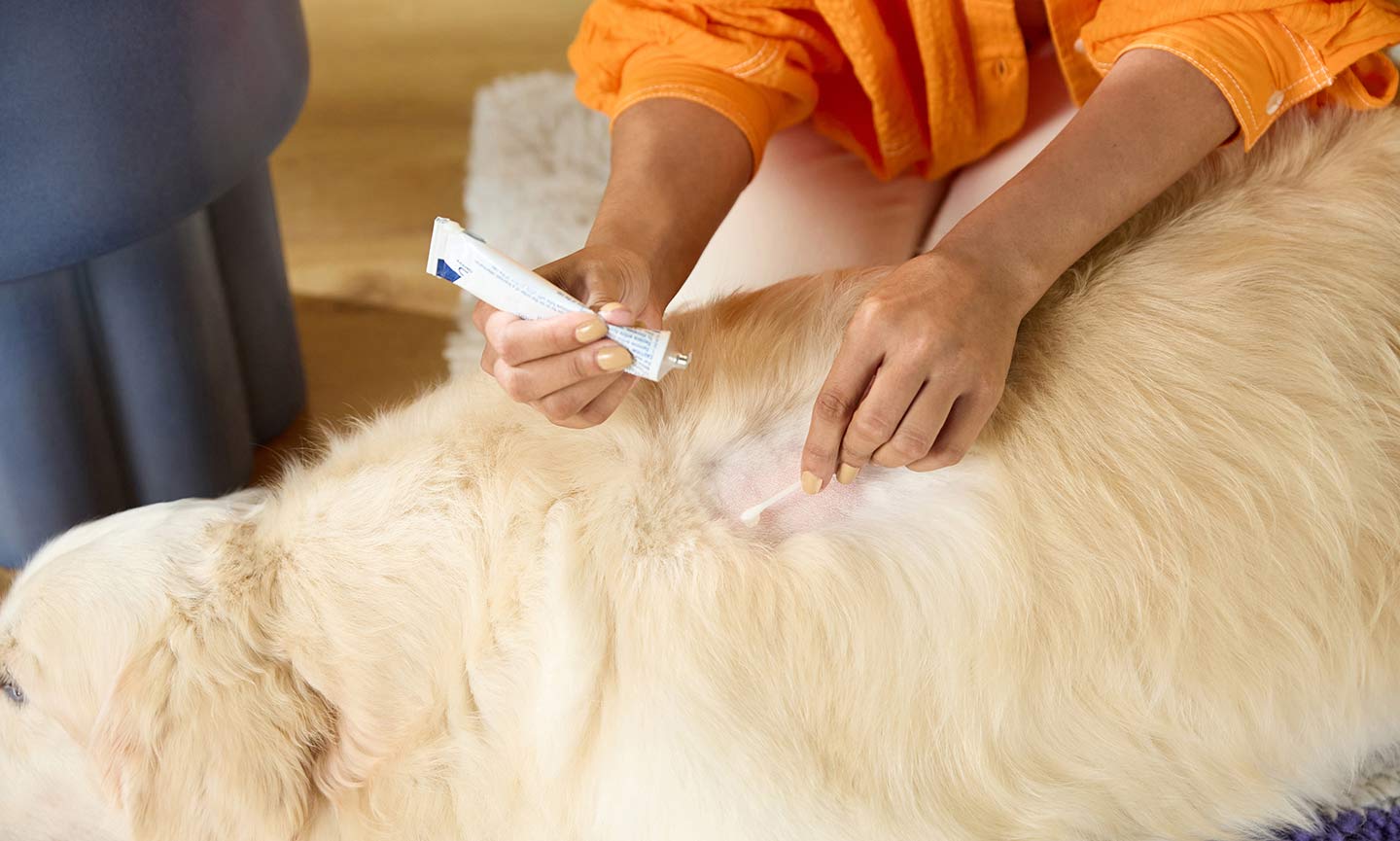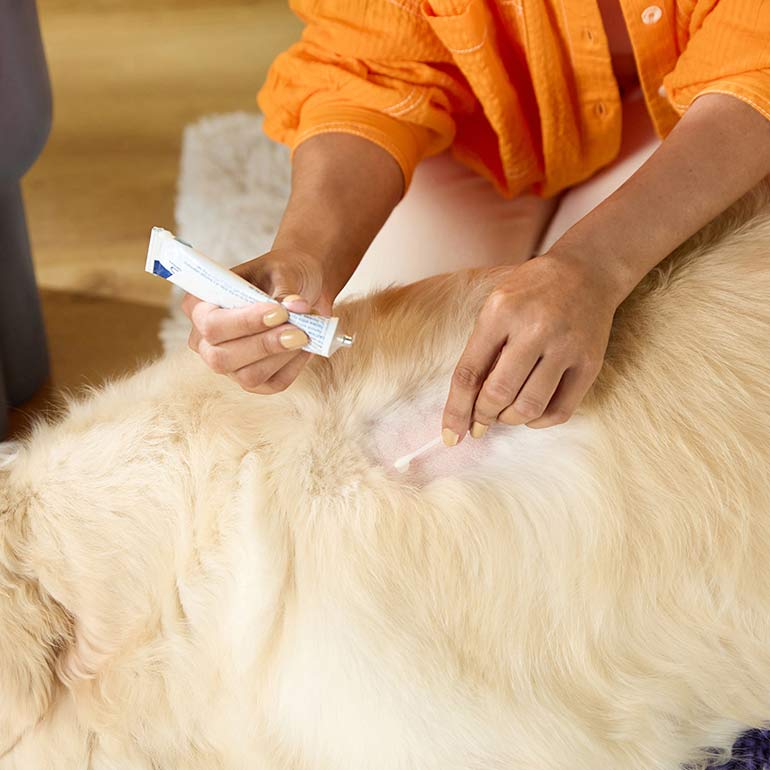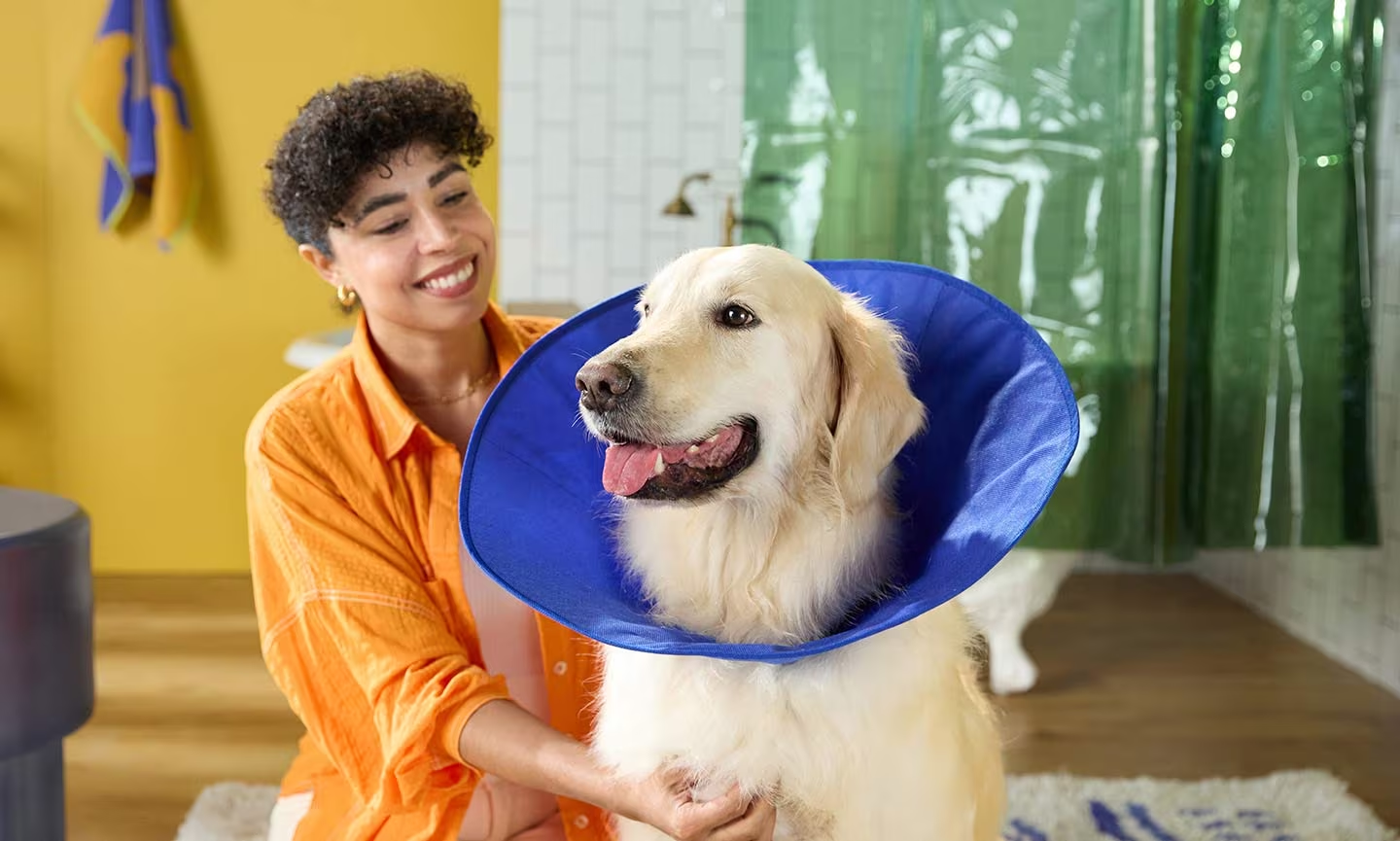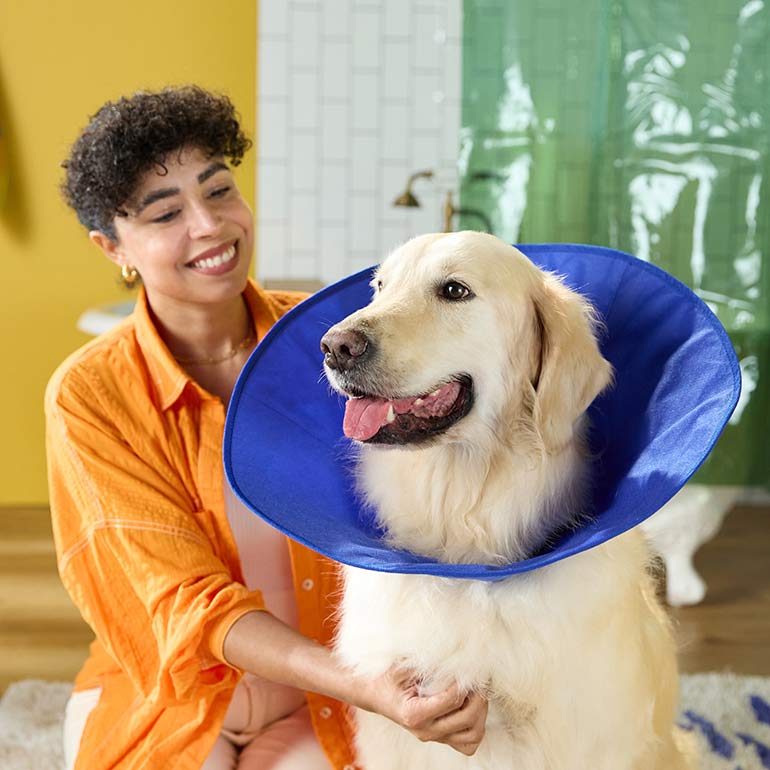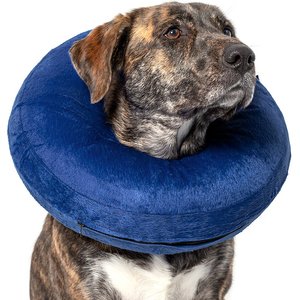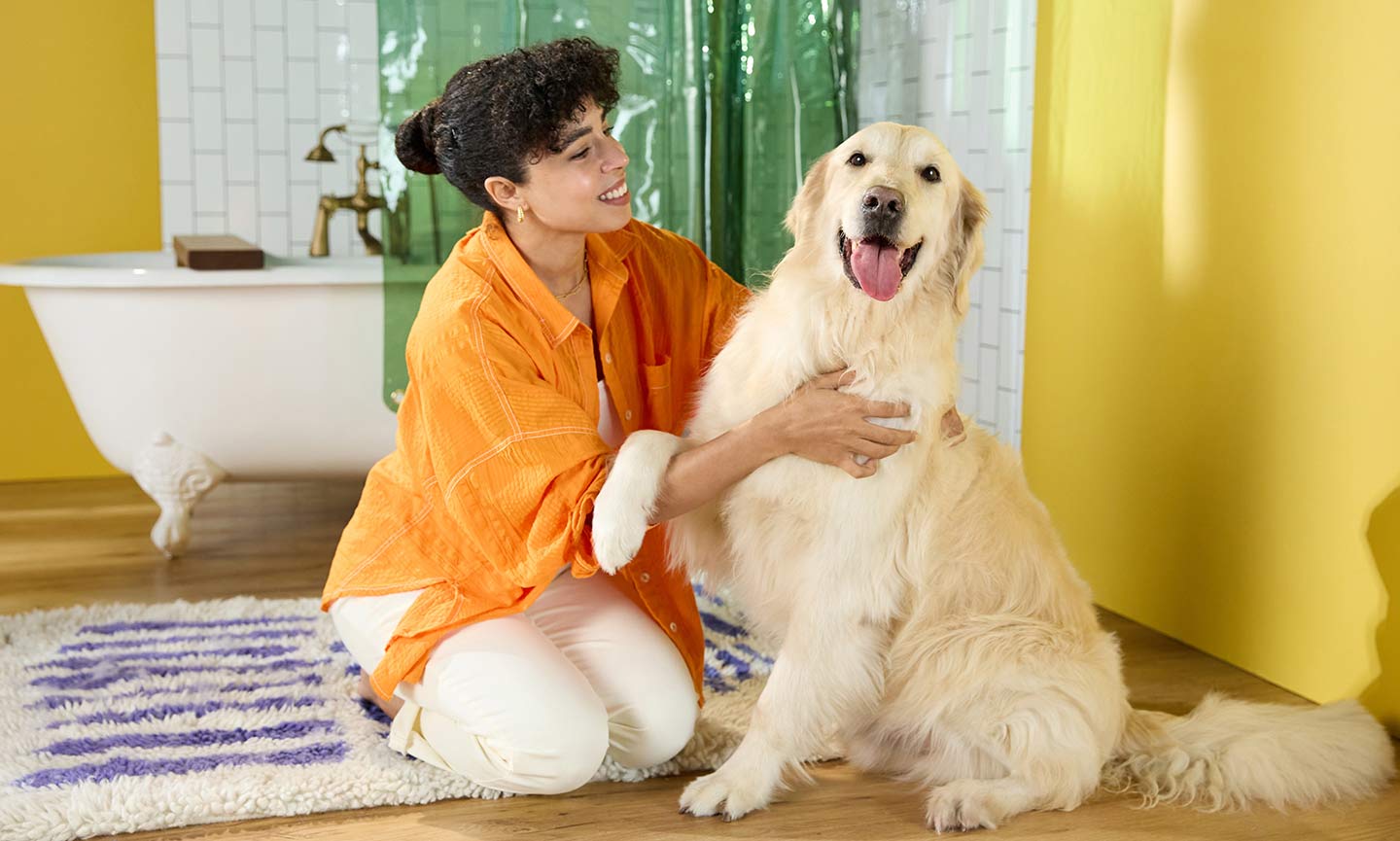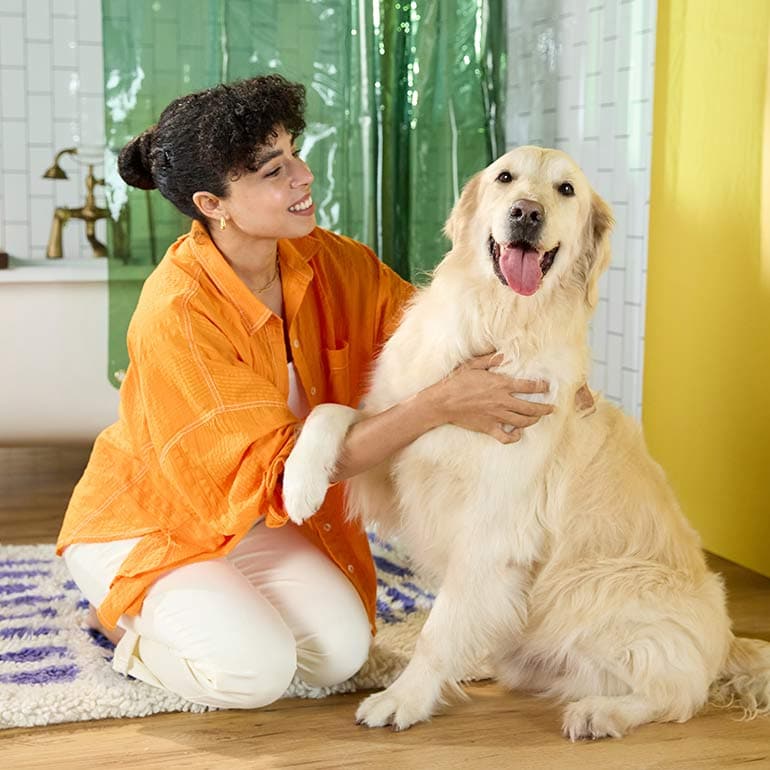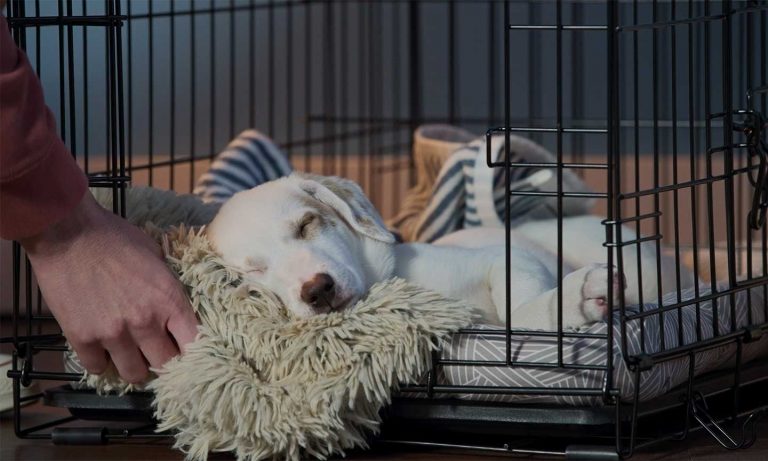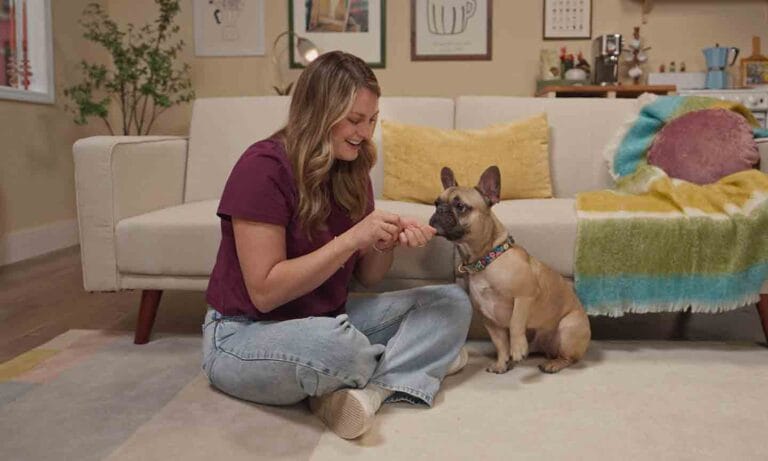In This Guide
What Are Dog Hot Spots?
Also known as pyotraumatic dermatitis or acute moist dermatitis, a hot spot is a skin lesion that’s characterized by:
- Redness and skin irritation
- Hair loss (often)
Hot spots are self-inflicted by your dog, created when they compulsively chew at a certain part of their body. They’re painful for your pup, and they’re also prone to secondary skin infections.
Where Do Hot Spots Usually Occur?
- The base of the tail
- The back of the legs
- The groin
- Around the neck
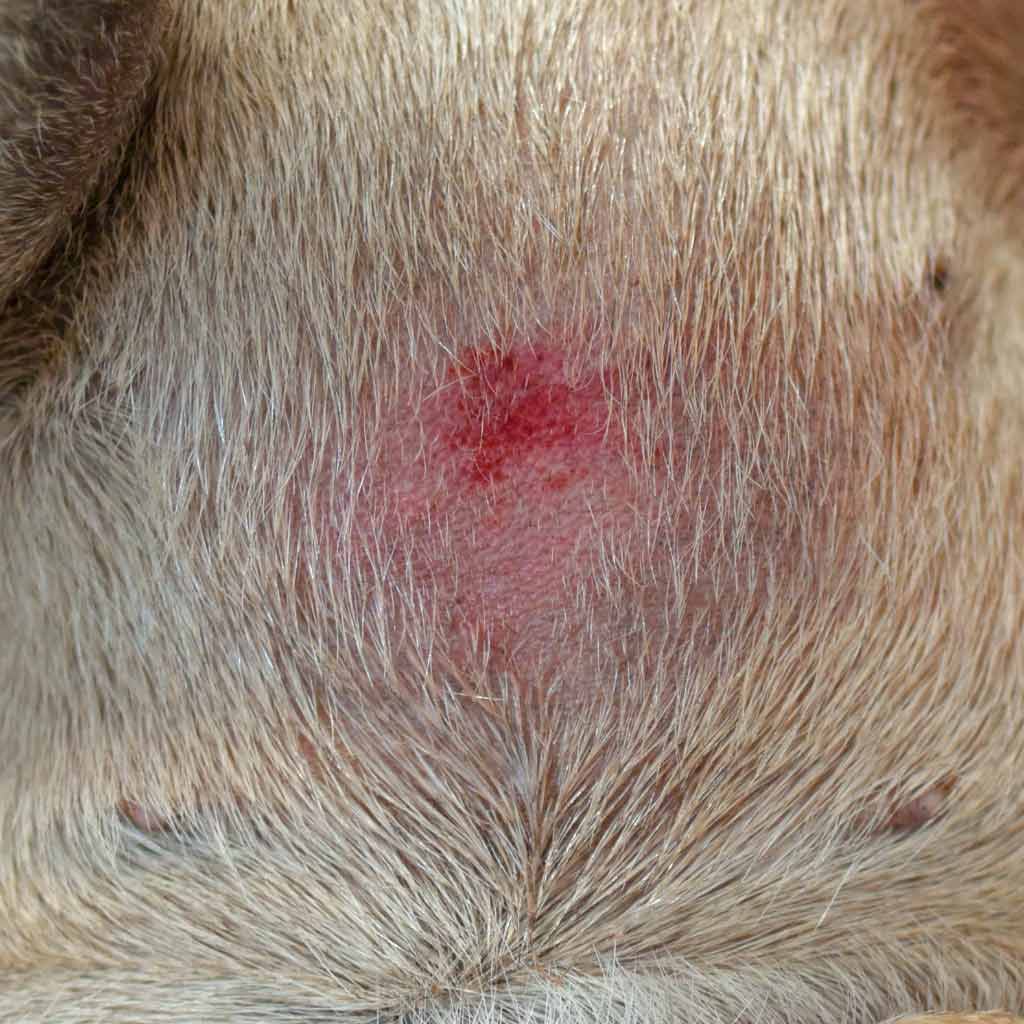
What Do Hot Spots Look Like on Dogs?
It’s usually possible to recognize a hot spot just by examining your dog’s skin. The first thing most pet parents notice is an area (it’s often roughly round or oval) where the fur is thin or missing altogether.
Inside this patch of hair loss, you may find spots that are red and oozy or darker and crusty. Red, oozy spots tend to be newer, while the dark crusty areas are older and may be starting to heal (although it’s hard to know what’s going on under the scab). Dogs can have more than one hot spot at a time.
Dog Hot Spots Vs. Ringworm
Other skin problems can also lead to patchy hair loss in dogs. Ringworm is a good example, but there are some differences in their symptoms that may help you figure out which condition is more likely.
Patchy hair loss
Patchy hair loss
Intensely itchy
Often not very itchy
Moist areas
Usually dry
Redness is more common in the middle of the patch of hair loss
Redness is more typical at the edge of the patch of hair loss
What Causes Dog Hot Spots?
The most common causes of hot spots in dogs include:
- Flea bite hypersensitivity (allergy to flea bites)
- Other hypersensitivities, including food allergies or seasonal allergies (atopic dermatitis)
- Ear infections
- Boredom, anxiety, or other compulsive disorders
- Anal gland itching or pain
- Skin fold infections
How to Treat Dog Hot Spots
Your first step in treating your dog’s hot spot? Contact your veterinarian. Different causes require different treatments, and your vet’s the best person to determine your dog’s underlying cause and appropriate treatment plan. This is especially important if:
- Your dog won’t stop scratching
- Your dog is shaking their head
- Your dog has hives
- The hot spots keep reoccurring.
Veterinarians can also prescribe medications that will help your dog get relief sooner.
Your vet’s advice may vary, but in general, this is how to help your dog’s hot spot heal:
1 Clip the hair around the hot spot with high quality clippers.
Use clippers to carefully trim the hair at the edges of the hot spot. Important note: Do not clip the hot spot itself, as this will be painful for your dog. Instead, clip the hair around the spot, which will prevent matted fur and excessive moisture from building up and causing further problems.
Bear in mind that a hot spot is painful and itchy, and your dog may not like what you are doing. Talk gently to your dog, and use precaution to avoid getting bitten. If necessary, ask for help from your veterinarian.
2 Gently clean the hot spot with a mild antiseptic that doesn’t sting.
Gently apply antiseptic to the hot spot. Some antiseptics, like Pet MD Chlorhexidine Antiseptic Wipes, come in wipe form; others come in a bottle of liquid that you’ll first apply to a gauze square and then apply to the hot spot. Dab, don’t wipe, and remember to be gentle as this may also be painful for your dog. Avoid products that contain alcohol because that will sting, and once again, bear in mind that your dog may bite.
The good news is that you’ll only need to do this once. Antiseptics can inhibit and kill bacterial skin infections, but they also interfere with skin healing, so this is a one-time job.
3 Apply a topical treatment to the affected area.
A number of creams, ointments and lotions are available to treat hot spots. The most effective treatments are:
- Antibacterial
- Anti-inflammatory
- Contain a steroid
- Contain antibiotics
Your vet will be able to prescribe the best treatment for your pet. Over-the-counter products and home remedies may not be strong enough to provide much relief.
It’s also not a good idea to give your dog over-the-counter antihistamines for their hot spot. Though most hot spots are caused by allergies, the reaction is so severe that non-prescription allergy medications typically do not help reduce their itching.
Continue applying the treatment according to its instructions until all of these occur:
- The hot spot is no longer red or oozing
- Your dog is no longer itchy
- The skin appears to be healing
- and hair starts regrowing
4 Place an Elizabethan collar on your dog.
An Elizabethan collar, aka an e-collar or cone collar, can prevent your dog from licking the hot spot—and just as importantly, licking the medication off the hot spot. This is an important part of treatment, because the hot spot will take longer to heal or may get worse if the dog is allowed to lick it.
Keep the e-collar on your dog whenever you’re not able to closely supervise them. You can take it off when you are cuddling together, for instance, or taking a leashed walk. However, you must watch your dog closely and prevent them from licking or chewing at the hot spot at all times when the collar is off.
5 Monitor your dog for improvement.
Check your dog’s hot spot daily to make sure it’s getting better. Signs of healing include:
- Decreased redness and oozing; the skin “dries up”
- Hot spot develops crusting or a scab
- Dog seems comfortable and isn’t trying to bite the hot spot; less itchiness
- Hair begins to regrow
Sometimes it can be hard to tell if a hot spot is improving. One way to keep track is to take a picture of the hot spot once a day for comparison.
Home Remedies for Dog Hot Spots
If you catch a hot spot early, a little home treatment with items you might already have on hand (or can get at a nearby pharmacy) may help you avoid a trip to the veterinarian. Follow these steps:
- Gently clip the fur from around the hot spot to let you see how extensive the problem is and to help the area dry out. Only use scissors if you’re sure you won’t nick your dog’s skin.
- Clean the area with cool water and mild hand soap (Cetaphil or Dove, for example). Pat the skin dry with a clean paper towel and then let it thoroughly air dry. Repeat once daily.
- Apply a thin layer of antibiotic cream containing neomycin, polymyxin b, and pramoxine (Neosporin or its generic equivalent). Avoid using an ointment as this will trap moisture on the hot spot. Repeat three times a day.
- Once the antibiotic cream is absorbed, apply a thin layer of hydrocortisone cream (not ointment) to the area. Repeat three times a day.
- Prevent your dog from licking or scratching the hot spot by covering it with a breathable sock or T-shirt or by using an Elizabethan collar.
If you want to try a natural home remedy, replace the antibiotic and hydrocortisone creams with black tea and oatmeal. Soak a tea bag filled with black tea in hot water, let it cool, and apply to the hot spot for a few minutes. Remove the tea bag and lightly press some ground oatmeal onto the affected skin. Repeat three times a day.
When to Call Your Vet
- If your dog doesn’t seem any better and is still itchy after two days of hot spot treatment
- If the hot spot improves and then it gets worse
Hotspots can mimic other skin conditions like mites, so your vet should take another look to determine what’s going on. They may prescribe oral steroids or other anti-itching medication and oral antibiotics.
Remember: Treating the hot spot alone isn’t enough. Talk to your vet to determine what caused the hot spot and what steps to take to address the issue.
Vet Treatment for Dog Hot Spots
Hot spots are so itchy that sometimes dogs will find it nearly impossible to stop scratching, licking or chewing at them, even with appropriate topical care. This leads to a cycle of more skin damage, which can result in a skin infection, and even more itching, scratching, licking and chewing. Veterinary treatment is necessary for severe hot spots or if your home remedy or over-the-counter treatment isn’t working.
Topical therapy will be similar to what you may have already tried, consisting of clipping the area, using sprays or creams to treat infection and itching, and Elizabethan collars or other barriers to prevent licking, chewing and scratching. But in addition, your veterinarian may also prescribe:
- Oral or injectable corticosteroids to ease itching and discomfort. A short course of oral prednisone is a common recommendation.
- Oral or injectable antibiotics. Your veterinarian will pick an appropriate antibiotic based on the specifics of your dog’s case. Cephalexin and amoxicillin-clavulanic acid are common choices. Fluoroquinolones like enrofloxacin or ciprofloxacin may be appropriate in certain circumstances.
Your vet will also look for an underlying cause for your dog’s hot spot and recommend appropriate treatment for that as well. Dogs with flea infestations, allergies, behavioral issues, or chronic ear, anal gland, or skin fold infections will keep getting hot spots until those problems are dealt with as well.
Dog Hot Spot Healing Stages
Hot spots will start to heal once any infection that is present is gone and the itching goes away. With appropriate treatment, healing occurs in three stages:
- First, the redness and ooziness will lessen and eventually disappear, leaving behind a patch of skin that may be partially or fully covered with something that looks like a crust or scab. This generally takes 3 to 7 days.
- Then, the crusts and scabs will loosen and fall off, which usually takes another 5 days or so. At this point, the skin underneath is usually pink or darker than normal.
- Finally, the skin’s color will return to normal and the hair will gradually regrow. Complete hair regrowth may take a month or more.
Talk to your veterinarian if your dog’s hot spots fail to improve or initially get better but then begin to worsen again.
How to Prevent Hot Spots on Dogs
While hot spots are a pain (literally), there are measures you can take to reduce the likelihood that your dog will suffer from them.
- Use an effective flea treatment on all pets in the household. Most dog hot spots are caused by a flea allergy—even one flea bite in an allergic dog can cause significant itching and a rash of hot spots to appear. If you have a heavy flea infestation in your house or yard, then you will need to treat the environment for fleas as well.
- To prevent ear infections, apply ear drops that dry and acidify your dog’s ears after swimming or baths, and/or put cotton balls in your dog’s ears during baths or swimming (don’t forget to remove them!). Find out more about cleaning your dog’s ears.
- If your dog is licking or chewing excessively because they are bored or have behavioral issues, decrease boredom with interactive toys or food puzzles and increasing training and exercise, and visit a veterinary behaviorist for more severe compulsive disorders.
- Clean skin folds on the face or around the tail regularly with an antiseptic wipe.
- If your dog has a history of problems with their anal glands, have them expressed every 6-8 weeks.
Keep Your Dog Healthy
Share:
